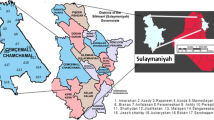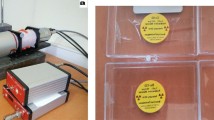Abstract
The gross α–β activities of 226Ra, 232Th and 40K in underground water samples were determined and γ spectroscopy measurements made as well. The gross α–β concentrations were measured using a low background gasless automatic α–β counting system calibrated with 241Am and 90Sr standards for α and β, respectively, while γ analyses were carried out using γ spectrometry system coupled to a NaI (TI) detector and measuring assembly. Gross α activities in the water samples varied from 15.7 to 142.7 mBq/L, registering an average value of 40.7 ± 12 mBq/L, whereas gross β activities ranged from 89.3 to 400 mBq/L. The activities of 226Ra, 232Th and 40K were 22.41 ± 6.07, 114.62 ± 13.01 and 227.38 ± 12.16 mBq/L, respectively. The mean annual effective dose due to water consumption was determined to be 7.00 ± 0.86 µSv/year per inhabitant. The gross α–β levels, the activities obtained for the three radionuclides and the annual effective dose were all within the WHO safe limits. This study indicates that underground water in the areas sampled is radiologically safe for consumption.

Similar content being viewed by others
References
Agbalagba EO, Avwiri GO, Ononugbo CP (2013) Activity concentration and radiological impact assessment of 226Ra, 228Ra and 40 K in drinking waters from (OML) 30, 58 and 61 oil fields and host communities in Niger Delta region of Nigeria. J Environ Radioact 116:197–200. doi:10.1016/j.jenvrad.2012.08.017
Al-Amir SM, Al-Hamarneh IF, Al-Abed T, Awadallah M (2012) Natural radioactivity in tap water and associated age-dependent dose and lifetime risk assessment in Amman, Jordan. Appl Radiat Isot 70:692–698. doi:10.1016/j.apradiso.2011.12.002
Avwiri GO, Tchokossa P, Mokobia CE (2007) Natural radionuclides in borehole water in Port Harcourt, Rivers State, Nigeria. Radiat Prot Dosim 123:509–514. doi:10.1093/rpd/ncl526
Bonotto DM, Bueno TO, Tessari BW, Silva A (2009) The natural radioactivity in water by gross alpha and beta measurements. Radiat Meas 44:92–101. doi:10.1016/j.radmeas.2008.10.015
Canu IG, Laurent O, Pires N et al (2011) Commentary health effects of naturally radioactive water ingestion: the need for enhanced studies. Environ Health Perspect 19:1676–1680
Caroli S, Forte M, Nuccetelli C et al (2013) A short review on radioactivity in drinking water as assessed by radiometric and Inductively Coupled Plasma-Mass Spectrometry techniques. Microchem J 107:95–100. doi:10.1016/j.microc.2012.07.014
Degerlier M, Karahan G (2010) Natural radioactivity in various surface waters in Adana, Turkey. Desalination 261:126–130. doi:10.1016/j.desal.2010.05.020
El-mageed AIA, El-Kamel AE, Abbady AE et al (2013) Natural radioactivity of ground and hot spring water in some areas in Yemen. Desalination 321:28–31. doi:10.1016/j.desal.2011.11.022
Faanu A, Adukpo OK, Okoto RJS et al (2011a) Determination of radionuclides in underground water sources within the environments of University of Cape Coast. Res J Environ Earth Sci 3:269–274
Faanu A, Ephraim JH, Darko EO (2011b) Assessment of public exposure to naturally occurring radioactive materials from mining and mineral processing activities of Tarkwa Goldmine in Ghana. Environ Monit Assess 180:15–29
Ibrahim A, El-mageed A, El-kamel AE et al (2011) Natural radioactivity of ground and hot spring water in some areas in Yemen. Desalination. doi:10.1016/j.desal.2011.11.022
Khayet M, Matsuura T (2013) Radioactive decontamination of water. Desalination 321:1–2. doi:10.1016/j.desal.2013.05.004
Khodashenas A, Roayaei E, Abtahi SM, Ardalani E (2012) Evaluation of naturally occurring radioactive materials (NORM) in the South Western oil wells of Iran. J Environ Radioact 109:71–75. doi:10.1016/j.jenvrad.2012.01.014
Nriagu J, Nam D-H, Ayanwola TA et al (2012) High levels of uranium in groundwater of Ulaanbaatar, Mongolia. Sci Total Environ 414:722–762. doi:10.1016/j.scitotenv.2011.11.037
Oresengun MO, Decker KM, Sanderson CG (2010) Determination of self absorption correction by computation in routine gamma-ray spectrometry for typical environmental samples. J Radioact Radiochem 4:38–45
WHO (2004) Guidelines for drinking, vol 1, 3rd edn, pp 1–515
Acknowledgments
We gladly acknowledge Radiation Protection Institute of the Ghana Atomic Energy Commission, Accra, Ghana for allowing us use their facility.
Author information
Authors and Affiliations
Corresponding author
Rights and permissions
About this article
Cite this article
Darko, G., Faanu, A., Akoto, O. et al. Assessment of the activity of radionuclides and radiological impacts of consuming underground water in Kumasi, Ghana. Environ Earth Sci 73, 399–404 (2015). https://doi.org/10.1007/s12665-014-3433-0
Received:
Accepted:
Published:
Issue Date:
DOI: https://doi.org/10.1007/s12665-014-3433-0




